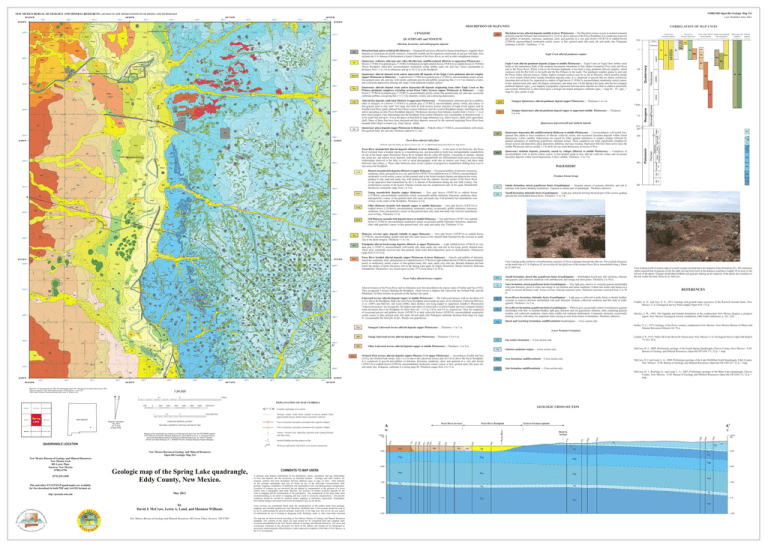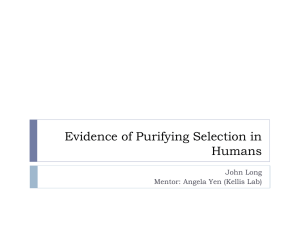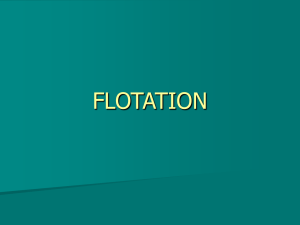F M M M o
advertisement

NMBGMR Open-file Geologic Map 214 Last Modified June 2011 NEW MEXICO BUREAU OF GEOLOGY AND MINERAL RESOURCES A DIVISION OF NEW MEXICO INSTITUTE OF MINING AND TECHNOLOGY Hmp3 Qa Qpe3 Hcr Qpe4 Qpe4 Qlt3 daf Qafd Hcr Qbt Qlt1 Qds daf Qds daf daf Qbt Qbt Qbt Qbt Py Py Ptm Qlt2 Py daf Qbs Qot daf Hmp3 Qabp daf Ptm Ptd daf Ptd Qd Qd daf Qd Qd Ptd Qac Ptd Qd daf daf Ptd 3633000 Qd daf Ptd Ptd Py Hmp1 Ptd Ps o Hmp1 Qlt3 16431 Qot Qbs Qlt1 Qbs Qds Qbs Qlt3 Qlt2 Qds Qds daf Qds Qlt1 Qds Qot Qds Qds Qds Qds Hmp3 Qds Qd Qds Hmp2 Qds Qd f Qa daf daf Qbs Qlt2 Qd daf Qlt3 Qds Qafe hmp4 Qa Qd daf Qd daf Qaf Psd Psg hmp4 Psg daf daf M Qd daf M Psd Psg Psg daf Qlt1 Hcr Qbs daf daf Qbs Qbs Qa Qbs daf daf Qbs Qa Qot daf Hmp3 Hmp2 Qac Qa Qaf daf Psd daf daf Psd Psd Qbs Qlt2 Qa daf Qa F 104°22'30"W 559000 560000 561000 562000 Qd daf daf 32°45'0"N Qbs 563000 104°20'0"W 564000 Base from U.S.Geological Survey 1955, from photographs taken 1947, toporgraphy from plane table surveys 1955. Polyconic projection. 1927 North American datum, UTM projection -- zone 13N 1000- meter Universal Transverse Mercator grid, zone 13, shown in red Psg Qd daf 565000 104°17'30"W Qd Qd f Qd daf Ptm Qlt3 Ps Qlt2 Ptd Ptm Qd Ptd Qd A' Qlt1 Qd daf Ptm Py 567000 568000 3624000 Ptd Py daf Ps Qd Qd daf daf Ptm Py Ptm Qot Qd Qd Qd Qds ? ? Qbt Ps Pt Py Psr 0.5 0 Young Lakewood terrace alluvial deposits (upper Pleistocene) —Thickness 1.5 to 5 m. Pye Pa 290 Ptd Qd 569000 REFERENCES Fiedler, A. G., and Nye, S. S., 1933, Geology and ground-water resources of the Roswell artesian basin, New Mexico: U.S. Geological Survey Water-supply Paper 639, 372 p. Hawley, J. W., 1993, The Ogallala and Gatuña formations in the southeastern New Mexico Region, a progress report: New Mexico Geological Society Guidebook, 44th Field Conference, p. 261- 269. Lyford, F. P., 1973, Valley fill in the Roswell-Artesia area, New Mexico: U.S. Geological Survey Open-file Report 73-163, 26 p. San Andres formation — Cross section only. Pg Glorieta sandstone tongue — Cross section only. McCraw, D. J., 2008, Preliminary geology of the South Spring Quadrangle, Chaves County, New Mexico: N.M. Bureau of Geology and Mineral Resources, Open-file OF-GM 171, 32 p. + map. Orchard Park terrace alluvial deposits (upper Pliocene (?) to upper Pleistocene) — According to Fiedler and Nye (1933), the Orchard Park terrace rises 1.5-3 m above the Lakewood terrace and 10.5-20 m above the Pecos floodplain. It is comprised of gravels and pebbles of dolomite, limestone, sandstone, chert, and quartzite in a very pale brown (10YR7/4) to reddish brown (5YR4/4), unconsolidated, moderately sorted, coarse- to fine- grained sand, silty sand, silt, and sandy clay. Pedogenic carbonate is a strong stage III. Thickness ranges from 3 to 15 m. Pye Yeso formation, undifferentiated — Cross section only. McCraw, D. J. and Land, L. A., 2008, Preliminary geology of the Lake McMillan North Quadrangle, Eddy County, New Mexico: N.M. Bureau of Geology and Mineral Resources, Open-file OF-GM 167, 32 p. + map. Pa Abo formation, undifferentiated — Cross section only. McCraw, D. J., Rawling, G., and Land, L. A., 2007, Preliminary geology of the Bitter Lake Quadrangle, Chaves County, New Mexico: N.M. Bureau of Geology and Mineral Resources, Open-file OF-GM 111, 32 p. + map. Qd 570000 View looking north of eastern edge of a small warped synclinal basin developed in Yates formation (Py). The outermost oldest exposed bed of gypsum on the far right curving from truck in the distance resurfaces roughly 20 m away to the left out of the photo. Younger interbedded redbeds and gypsum making up the majority of the photo also resurface to the left within this bed. Photo by D. McCraw. Psa Older Lakewood terrace alluvial deposits (upper to middle Pleistocene) —Thickness ~2 to 9 m. 32°45'0"N 104°15'0"W 1 MILE Geologic contact. Solid where exposed or known, dashed where approximately known, dotted where concealed or inferred. New Mexico Bureau of Geology and Mineral Resources New Mexico Tech 801 Leroy Place Socorro, New Mexico 87801-4796 [575] 835-5490 This and other STATEMAP quadrangles are available for free download in both PDF and ArcGIS formats at: http://geoinfo.nmt.edu 9578 Oil & gas exploration well used in cross section construction. 3,000’ New Mexico Bureau of Geology and Mineral Resources Open-file Geologic Map 214 Qot Qlt1 Qlt2 Qlt3 Qa Pt Pt Py Psr Py Pqg Pqg 4,000 ft ASL 1100 9 4 1005 8 1 1000 Inclined bedding showing degrees of dip. E Bend In Section 2942 4,000 ft ASL A’ 8 11 W Eastern Permian uplands 2936 QUADRANGLE LOCATION Artesia - Vacuum Arch. Subsurface anticlinal arch warping Permian and older strata. Pecos River floodplain 7275 Trace of anticline axial plane associated with evaporite collapse. LAKE MCMILLAN NORTH ILLINOIS CAMP Pecos River terraces A 9718 Trace of syncline axial plane associated with evaporite collapse. NATIONAL GEODETIC VERTICAL DATUM OF 1929 Pecos River CONTOUR INTERVAL 20 FEET 9464 1 KILOMETER Mapping of this quadrangle was funded by a matching-funds grant from the STATEMAP program of the National Cooperative Geologic Mapping Act, administered by the U. S. Geological Survey, and by the New Mexico Bureau of Geology and Mineral Resources, (Dr. Peter A. Scholle, Director and State Geologist, Dr. J. Michael Timmons, Geologic Mapping Program Manager). GEOLOGIC CROSS SECTION Location of geologic cross section. 9328 Magnetic Declination May 2004 10º 15' East At Map Center 0 A' 9768 NEW MEXICO RED LAKE 0.5 A 9931 7000 FEET 1 6000 1643 5000 9296 9320 4000 9217 DAYTON Spring SPRING LAKE Lake 3000 9256 1 ARTESIA 2000 9305 1000 7132 0 DIAMOND MOUND 9578 1000 ARTESIA NE Ps 3,000’ Psr Pqg Pqg Geologic map of the Spring Lake quadrangle, Eddy County, New Mexico. May 2011 by David J. McCraw, Lewis A. Land, and Shannon Williams New Mexico Bureau of Geology and Mineral Resources, 801 Leroy Place, Socorro, NM 87801 Psg Psa EXPLANATION OF MAP SYMBOLS ESPUELA Psd Pqg 1:24,000 1 Ptd Ptm 3625000 Ptd Qa Qd Kelley, V. C., 1971, Geology of the Pecos country, southeastern New Mexico: New Mexico Bureau of Mines and Mineral Resources Memoir 24, 78 p. Lower Permian Formations Qd Qd Ptm Qot Queen and Grayburg formations, undifferentiated (Guadelupian) — Cross section only. Youngest Lakewood terrace alluvial deposits (upper Pleistocene) — Thickness <1 to 1 m. Qd Qd Qd Seven Rivers formation, gypsiferous facies (Guadelupian) — White to gray, occasionally yellow to red massive gypsum interbedded with thin- to medium-bedded, light gray dolomite and red gypsiferous siltstone, often containing gypsum nodules, and yellowish sandstone, which often exhibit soft sediment deformation. Commonly fractured, occasionally forming caverns, with many low amplitude folds varying in scale from meters to kilometers. Thickness unknown. Psg daf Qd Qd daf Seven Rivers formation, dolomitic facies (Guadelupian) — Light gray to yellowish to pink, thinly to thickly bedded, vesicular to massive dolomite interbedded with pink dolomitic siltstone, yellowish sandstone and thin beds of milky gypsum. Thickness 1 to 3 m. Psd Pqg daf Qd daf Qd 3626000 Qd daf daf Qa Qd 566000 Ptm daf Qd Ptm Qa Ptm Ptm f 10054 11009 Ptm Ptd Psd f Ptm daf Qd Qd Qd 10008 daf daf Ptd Qd Py daf daf Qd daf daf daf daf daf Qlt3 Ptd daf Psd daf Qbs Psd Qd Lakewood terrace alluvial deposits (upper to middle Pleistocene) — The Lakewood terrace, with an elevation of 6 to 9 m above the floodplain, flanks the inset Pecos floodplain and extends up many of its tributaries. Following McCraw, et al. (2007) and McCraw and Land (2008), three distinct, low-lying (upper to uppermost middle(?) Pleistocene) “Lakewood terraces” are recognized. The highest and oldest of which (Qlt1) would be Fiedler and Nye’s original. Surface tread elevations above the floodplain for these three are: <1-2 m, 2-6 m, and 6-9 m, respectively. They are comprised of occasional gravels and pebbles, brown (10YR5/3) to dark yellowish brown (10YR3/4), unconsolidated, moderately sorted, coarse- to fine- grained sand, silty sand, silt and sandy clay. Pedogenic carbonate increases from stage I to stage II+ (occasionally III) from Qlt3 to Qlt1. Mostly non-gypsiferous. daf Yates formation, mixed gypsiferous facies (Guadelupian) — Very light gray, massive to vesicular gypsum interbedded with pink dolomite, green to white and orange to red siltstone and minor sandstone. Folded into domes and basins on a meter to several decimeter scale. Forms caverns. Outcrop exposures poor. Thickness increases westward from 2 to 50 m. Py Alluvial terraces of the Pecos River and its tributaries were first described in the classic study of Fiedler and Nye (1933). They recognized 3 terraces flanking the floodplain: (from lowest to highest) the Lakewood, the Orchard Park, and the Blackdom. All three terraces are present on the Spring Lake quad. 3627000 Tansill formation, mixed silty gypsiferous facies (Guadelupian) — Interbedded mixed gray silty dolomite, siltstone and gypsum, and yellowish sandstone with sublitharenite and orange-red chert grains. Thickness 2 to 50 m. Ptm Ptd Qd Ptd Psd Psg daf hmp4 3624000 daf Qd daf daf daf daf Ptd Ptd daf Qd Pecos Valley alluvial terrace complex Qd daf daf daf daf Qd Qd daf daf daf daf Ptm Ptd daf daf Qd Qd daf daf daf daf Tansill formation, dolomitic facies (Guadelupian) — Light gray dolomite forming the basal part of the section, grading upward into interbedded mixed facies. Thickness <1 to 3 m. View looking north-northwest of northernmost exposure of Ptd as it plunges beneath the alluvim. The roadside businesss on the north side of U.S. Highway 82 sits on alluvial fan (Qaf) east of the modern Pecos River meanderbelt (hmp4). Photo by D. McCraw. Ptm daf daf daf Qd Qd daf Qpe3 Old Holocene meander belt deposits (lower to middle Holocene) — Very pale brown (10YR7/4) to reddish brown (2.5YR4/6), unconsolidated, moderately sorted, occasionally pebbly (dolomite, limestone, sandstone, chert, and quartzite), coarse- to fine-grained sand, silty sand, and sandy clay. Thickness 3-5 m. daf daf daf daf Ptm Ptd Qpec2 Qpe4 Older Holocene meander belt deposits (upper to middle Holocene) — Very pale brown (10YR7/4) to reddish brown (2.5YR4/6), unconsolidated, moderately sorted, occasionally pebbly (dolomite, limestone, sandstone, chert, and quartzite), coarse- to fine-grained sand, silty sand, and sandy clay. Unit lies immediately west of Hmp3. Thickness 3-5 m. Qd Qd daf Qd daf Ptd daf daf daf daf daf daf Qd daf Psg daf Qd Psd daf Salado formation, mixed gypsiferous facies (Guadelupian) — Irregular masses of gypsum, dolomite, and salt in outcrops with chaotic bedding orientations. Exposed in eastern part of quadrangle. Thickness unknown. daf Qd Qd Qd Qd daf Qd daf 3628000 daf daf daf Qd daf daf Qd daf daf Ptd 269 Ps Pecos River braided alluvial deposits (upper Pleistocene to lower Holocene) — Gravels and pebbles of dolomite, limestone, sandstone, chert, and quartzite in a reddish brown (2.5YR4/6) to light reddish-brown (5YR6/4), unconsolidated, poorly to moderately sorted, coarse- to fine-grained sand, silty sand, sandy clay, and clay. Braided channels and bars typify the surface of Qabp elsewhere, but on the Spring Lake quad, its largely featureless. Mostly buried by Holocene meanderbelt. Thicknesses vary (based upon Lyford, 1973) from about 5 to 30 m. Qabp daf Ptd Qd Ptd daf daf daf daf daf daf daf daf Qd daf Qd daf daf Psd daf Qd daf daf daf F Py daf daf daf Ptd Qd daf daf daf Psd daf daf Qd Ptd Qd daf F Qlt3 3625000 daf daf daf Ptm daf 32°47'30"N daf daf daf daf daf daf daf daf Qd daf daf Qd Qa Hcr daf daf Psg Qaf daf daf 4 Psd daf daf Qaf Hmp3 daf Psd daf daf Qd daf Qd Ptm daf daf daf daf daf daf daf daf Qbs daf Py daf Qd daf daf daf Qd daf Ptd daf daf daf daf daf daf Ptm Qd daf daf daf daf Qd daf daf daf Qd Qa Qaf Qa daf M Qaft daf Qd Qa 3626000 Qd daf Qlt2 Floodplain alluvial backswamp deposits (Historic to upper Pleistocene) — Light reddish-brown (5YR6/4) to very dark gray (7.5YR3/1), unconsolidated, well-sorted, silty sand, sandy clay, and clay in low-lying, poorly drained areas. These areas commonly received only fine-grained, slack-water flood deposition, prior to channelization. Thicknesses range from 3-15 (?) m. Qbs Qd daf daf daf daf Qd daf daf Qd Qd daf daf Qd daf Qa daf Ptd Qd Py daf daf Qd daf daf 3629000 daf daf daf daf Qd daf daf daf Psd M Qd Ptd Py daf 258 Permian Artesia Group Young meanderbelt deposits (upper Holocene) — Very pale brown (10YR7/4) to reddish brown (2.5YR4/6), unconsolidated, moderately sorted, occasionally pebbly (dolomite, limestone, sandstone, chert, and quartzite), coarse- to fine-grained sand, silty sand, and sandy clay. Unit primarily lies immediately west of hmp4 in the center of the floodplain. Thickness 2-5 m. Qabp Holocene crevasse splay deposits (middle to upper Holocene) — Very pale brown (10YR7/4) to reddish brown (2.5YR4/6), unconsolidated, graded sand and silty sand closest to the channel bank breached by the crevasse to sandy clay at the distal margins. Thickness <1 to 2 m. Hcr Qd Ptm daf Qd Qd daf daf daf Qd daf daf daf daf o daf Psd Qd daf Qd daf Py Qd daf Psd daf daf Qbs Qlt3 daf Psd daf Qa daf daf Qd o4 Ptm daf Qd Qd Ptm Ps Ptd daf daf daf daf daf Qd Psd daf Qd daf Qd Qd daf Ptd Qd Qlt3 daf daf 5.3 23.0 250 PALEOZOIC Historic meanderbelt deposits (Historic to upper Holocene) — Occasional pebbles of dolomite, limestone, sandstone, chert, and quartzite in a very pale brown (10YR7/4) to reddish brown (2.5YR4/6), unconsolidated, moderately to well-sorted, coarse- to fine-grained sand in the former modern channel and adjacent bar crests, grading to silty sand and sandy clay with distance from this channel. Several reaches of the Pecos River on the quad have been channelized by the U.S. Bureau of Reclamation during the mid 20th Century. The northernmost section of the Kaiser Channel extends into the southernmost part of the quad. Meanderbelt thicknesses commonly range from 1 to 5 m. Qlt3 Qbs 780 Quaternary sinkhole deposits, primarily caused by collapse (Historic to middle Pleistocene) — Complexes of unconsolidated, well- to poorly-sorted, coarse- to fine-grained sands to clay, alluvial, colluvial, eolian, and occasional lacustrine deposits within closed depressions. Colors variable. Thickness <1 to 3 m. Qds Qp Depressions and Permian sinkholes bedrock Ps Qd Ptd daf Ptd daf Qd Qd Qd Qd daf Qd Qa Qlt3 Qlt3 Qd Qa Qd Qd Qd Psd daf Qlt3 Qlt3 Qlt3 Qd Qaf Hmp3 daf o1 Py Psd M 3627000 Psg Qd daf Psd Qd daf o Qd Qlt1 Qds f29421 5 Psd 7275 daf Qd daf Qd Qd Ptm Psg Psg Qbs Qds daf Qd Qd Qlt3 Hmp1 Qlt3 Ptd f29368 Qd Qlt3 daf Qlt3 3630000 Ptd Qd Psg Qaf Qlt3 daf Qd Ptd daf Qlt3 Ptd Qd Qa Qlt3 Qlt3 Ptm Qa Qds Py Hmp2 Ptd Ptm Ptm Qd Qd daf Py Qd daf daf Qd Qd Ptd Ptd Qd daf Py Ptd daf Ptm Hmp3 daf Qd Ptd daf Ptd 3631000 Ptd daf Qd Qlt3 Qd Psg Qds Qac Ptd Ptm Psd Qd Ptd Qd Qd Ptm Ptd Qds Qds Qds Qd Py Qlt3 daf Ptd Qds Qds Ptm daf Qds Qlt2 3628000 Psd Qd 3 Qd Qa Psd Qds Qlt3 Qd Qbs Qds Qbs Qd daf o Ptm daf Qd 14 Qlt3 7 Qa Qds daf Qds Qac Qaf Hmp3 daf Qlt3 Ptm Qd 6 Qa Qaf Qafe Qot Qbs Qd Ptd Ptd 9718 Ptd Qds Qlt3 f Py Qd Qa Hmp3 Qafe Qlt1 Hmp3 Ptd Qd Qd Qa hmp4 Ptd Ptd daf Qa Psd Psg daf Ptd Ptm Py Psg o f Qa 9768 Qds Qac f Qd Qd Qbs Qd Ptd Qd Qd o Qac Hmp3 9464 daf 3632000 daf daf Ptd Psg Psd Psg Ptd Qd Qd Py Qaf Qds Qlt1 Qot daf daf o f 9328 Qds f Qd daf 6 daf Py Psd Ptd Ptd F Qbs Qot 7132 Qd Qd hmp4 Hmp3 Ptd Qd Qd Ptd F Qlt2 f9217 Ptm Qd Py daf Ptd Qd Ptd daf Ptm o f 9320 Hcr Qlt3 Qa Qlt1 o Psg Qbs Qac Qd daf Psd f f9256 32°47'30"N Qafl 9931 Qot 3629000 Psd Psg f9296 f9305 Qbs Ptd Qd Qd 3 Psd Qd Hmp2 Qlt1 3631000 daf Qd daf Qd Hmp3 Qbs Qd Qd Qd Pecos River meanderbelt alluvial deposits (Historic to lower Holocene) — At the onset of the Holocene, the Pecos River switched from a braided regime to a meandering one, and proceeded to build four distinguishable meanderbelts on top of the basal, upper Pleistocene Pecos River braided alluvial valley-fill (Qabp). Consisting of channel, channel bar, point bar, and natural levee deposits, undivided, these meanderbelts are differentiated based upon cross-cutting relationships observed in the field, as well as aerial photographic work into an historic unit (hmp4) and three older Holocene units (Hmp1-3). These older Holocene units reveal a pattern of progressive meanderbelt shifting from west to east across the floodplain. Qd 2 Qd Psd Ptd Qd Ptd Qd daf Qac daf o f Psg daf (Historic map unit labels are given a lower case “h” to differentiate them from Holocene map units.) Ptd daf Qd daf Hmp3 3630000 Qd Qd Qlt1 Ptd Ptm Hcr f9578 A Qd Ptm daf Ptd Ptd Qd Ptd Qd Ptd Qds Psd daf 3632000 daf daf Qd daf Qlt2 Qlt1 Qac Qds Psd Qd Pecos River alluvial valley floor 32°50'0"N Younger Quaternary alluvial piedmont deposit (upper to uppermost middle Pleistocene) — Thickness 2 to 4 m. Quaternary depression fill, undifferentiated (Holocene to middle Pleistocene) — Unconsolidated, well-sorted, finegrained (fine sands to clay) complexes of alluvial, colluvial, eolian, and occasional lacustrine deposits within closed depressions. Colors variable. Depressions are created by either gradual subsidence or sudden collapse followed by gradual subsidence of underlying gypsiferous carbonate terrane. These complexes are often significantly modified by stream erosion and deposition, playa deposition, deflation, and mass wasting. Depression fills have been active since the middle Pleistocene and are usually 1-3 m thick but can reach thicknesses in excess of 30 m. 3633000 daf 128 Youngest Quaternary alluvial piedmont deposit (upper Pleistocene) — Thickness 1 to 3 m. Quaternary depression fill and sinkhole deposits Qd Qd Ptd Ptd daf 7 Qbs Qd Qd Qd Qpe3 Qaf, Qafd, Qafe, Qafh, Qafl, Qaft hmp4 Hmp3 Hcr Hmp2 Hmp1 Pecos Valley alluvial Eagle Creek piedmont terrace deposits alluvial deposits Qlt1 1.8 Ma daf F Qaf Qlt3 Qpe4 Quaternary playa deposits (upper Pleistocene to Holocene) — Pinkish white (7.5YR8/2), unconsolidated, well-sorted, fine-grained sand, silt, and clay Thickness unknown (≥ 1m). Qp daf Qd 32°50'0"N 3634000 Qd daf Qafh hmp4 Qa Ps 6 daf Qd Ptm daf daf daf Qd Qd Qd Qd daf Qd Ptm o daf daf daf Qd Qbt daf 3634000 daf Quaternary alluvial channel swale and/or depression fill deposits of the Eagle Creek piedmont alluvial complex (upper Pleistocene to Holocene) — Light brown (7.5YR6/4) to pinkish gray (7.5YR6/2), unconsolidated, poorly sorted, fine-grained sand, silt, and clay with mostly carbonate gravels and pebbles occupying thin (<1-1.5 m) channels, swales, and coalescing depressions draining the Eagle Creek piedmont complex (QTpe). Alluvial-fan deposits, undivided (Historic to uppermost Pleistocene) — Predominantly carbonate gravels to pebbles, often in stringers, in a brown (7.5YR4/2) to pinkish gray (7.5YR6/2), unconsolidated, poorly sorted, and coarse- to fine-grained sand to silty sand. Two large fans built by both historic former channels of Eagle Creek (Qafe), and by Tumbleweed Draw (Qaft), debouch from these western tributaries onto the western floodplain margin, interfingering with and/or spreading out onto Pecos floodplain deposits. Thicknesses decrease from tributary mouths from ≥ 6 m to < 1 m at their distal margins. Fans debouching onto the floodplain from eastern tributaries vary considerably in thickness from <1 m for small fans and up to ~8 m at the apices of fans built by large tributaries (e.g., Hart Canyon , Qafh, and Logan Draw, Qafl). Many of these fans have been truncated and their deposits removed by the eastward migrating Pecos River from meander belts Hmp2 to hmp4 (e.g., Dog Canyon , Qafd). Qaf Qd Qac Eagle Creek alluvial piedmont deposits (Upper to middle Pleistocene) — Eagle Creek (or Eagle Draw further west) heads on the easternmost flank of the southern Sacramento Mountains in San Andres Formation (Psa) rocks and flows east to the Pecos River. Where it leaves the Permian highlands, it has built a large piedmont alluvial complex, which coalesces with the Rio Felix to the north and the Rio Peñasco to the south. This piedmont complex grades to and onto the Pecos Valley alluvial terraces. Oldest, highest remnant surfaces may be as old as Pliocene, which possibly grades to a river system which forms Gatuña formation deposits today. It is comprised of gravels that are almost exclusively limestone derived from Psa, supported in a matrix of light brown (7.5YR6/3), unconsolidated, moderately sorted, coarseto fine- grained sand, silty sand, silt (largely calcareous), and sandy clay. On the Spring Lake quad, only the two youngest piedmont deposits (Qpe3-4) are mapped. Topographic expression between these deposits are often to subtle to practically non-existent. Distinction is often based upon a stronger developed pedogenic carbonate (Qpe3 = stage III – II+; Qpe4 = stage II). Qpe4 grades to Qlt3. Quaternary alluvial channel swale and/or depression fill deposits originating from either Eagle Creek or Rio Peñasco piedmont complexes extending across Pecos Valley terraces (upper Pleistocene to Holocene) — Light brown (7.5YR6/4) to pinkish gray (7.5YR6/2), unconsolidated, poorly sorted, fine-grained sand, silt, and clay, occasional carbonate pebbles, occupying thin (<1-1.5 m) channels, swales, and coalescing depressions. Qac Qa Qot Qafh daf 3635000 Ps Ptm 9 Py Qd Hmp1 Qlt1 Qd daf Qa Qot Hmp2 Qd Qbt Qd Qot Qot Qpec2 Py Qbt Qd Qbt Qabp Qpe3 daf Ptm Ps daf Qa Eagle Creek alluvial piedmont complex Quaternary tributary alluvium and valley-fill alluvium, undifferentiated (Historic to uppermost Pleistocene) — Brown (7.5YR4/2) to pinkish gray (7.5YR6/2) (tributaries) to light reddish-brown (5YR 6/4) to reddish brown (2.5YR4/6) (Pecos floodplain valley-fill), unconsolidated, moderately sorted, pebbly sand, silt, and clay. Varies considerably in thickness from <1 to 3 m in tributaries and up to 10-12 m in the floodplain. Qa o daf Qd Qd Qbt Qa Qafh Hcr daf Qot Qbt Qbt Qot Qot daf Qbt Qbt daf Qd daf M Hmp2 daf Qa 3636000 Ptd Qd M Qot Qd daf Qd Qd Qlt3 Qbt Py Hmp2 Qd Qd Qd Qbt Qd Holocene 11 Disturbed land and/or artificial fill (Historic) — Dumped fill and areas affected by human disturbances, mapped where deposits or extractions are areally extensive. Especially notable are the numerous constructed oil and gas well pads. Also includes the U.S. Bureau of Reclamation’s Kaiser Channel of the Pecos River, as well as other straightened reaches. daf Ptd M daf Qpe3 Qd Hmp3 Hmp1 Qbt Ptd Qd Qd Qbs Hcr daf Qbt Qa Alluvium, lacustrine, and anthropogenic deposits Qd Historic upper M M hmp4 3636000 12 M Py Ptd 0 ka Pecos River alluvial valley floor middle Qpe3 Qpe4 Qd daf Alluvial and lacustrine deposits lower Qd Qbt Blackdom terrace alluvial deposits (middle to lower Pleistocene) —The Blackdom terrace occurs in isolated remnants primarily atop the Permian Yates formation (Py), 25-42 m above and east of the Pecos floodplain. It is comprised of gravels and pebbles of dolomite, limestone, sandstone, chert, and quartzite in a very pale brown (10YR7/4) to reddish brown (5YR4/4), unconsolidated, moderately sorted, coarse- to fine- grained sand, silty sand, silt, and sandy clay. Pedogenic carbonate is III-III+. Thickness ~17 m. Qbt QUATERNARY and NEOGENE Ptm Ptm Qa Py CENOZOIC 3637000 daf CORRELATION OF MAP UNITS Salado Fm F Qpe4 Qac daf Qd Qlt3 Qpe3 Qd Qa Qa Qbs Ps Py daf DESCRIPTION OF MAP UNITS Qd Yeso Fm Qac Hmp3 daf Py Py Abo Fm Qa Qpe4 Hmp2 Qabp Py daf 32°52'30"N Qp Qaf Py Pleistocene Qpe3 Hmp1 Qd 570000 Miocene Pliocene Qa Qd Ptm Qd M Qds daf Qa M M Qpe4 M Qa Qd 104°15'0"W 569000 Artesia Group San Andres Seven Yates Tansill QueenFm Grayburg Fms Rivers Fm Fm Fm Qaf Ptm 568000 Permian Qbs Py 567000 Quaternary daf hmp4 Qpe4 566000 M Qpe3 104°17'30"W 565000 Neogene Qlt3 Qac 3637000 3635000 564000 M Qds 563000 o Qds 104°20'0"W 562000 Paleozoic 561000 M 32°52'30"N 560000 M 559000 M 104°22'30"W 2,000’ COMMENTS TO MAP USERS A geologic map displays information on the distribution, nature, orientation, and age relationships of rock and deposits and the occurrence of structural features. Geologic and fault contacts are irregular surfaces that form boundaries between different types or ages of units. Data depicted on this geologic quadrangle map may be based on any of the following: reconnaissance field geologic mapping, compilation of published and unpublished work, and photogeologic interpretation. Locations of contacts are not surveyed, but are plotted by interpretation of the position of a given contact onto a topographic base map; therefore, the accuracy of contact locations depends on the scale of mapping and the interpretation of the geologist(s). Any enlargement of this map could cause misunderstanding in the detail of mapping and may result in erroneous interpretations. Site-specific conditions should be verified by detailed surface mapping or subsurface exploration. Topographic and cultural changes associated with recent development may not be shown. Cross sections are constructed based upon the interpretations of the author made from geologic mapping, and available geophysical, and subsurface (drillhole) data. Cross-sections should be used as an aid to understanding the general geologic framework of the map area, and not be the sole source of information for use in locating or designing wells, buildings, roads, or other man-made structures. The map has not been reviewed according to New Mexico Bureau of Geology and Mineral Resources standards. The contents of the report and map should not be considered final and complete until reviewed and published by the New Mexico Bureau of Geology and Mineral Resources. The views and conclusions contained in this document are those of the authors and should not be interpreted as necessarily representing the official policies, either expressed or implied, of the State of New Mexico, or the U.S. Government. 2,000’ Psa Psa Psa Psa 1,000’ 1,000’ Pg Pg Pg Pg 0’ SL Pye Pye 0’ SL Pye Pye -1,000’ -1,000’




